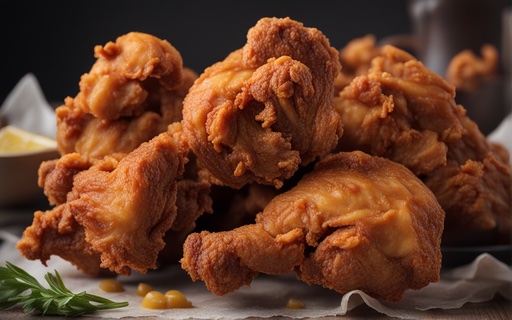Internet Asks: "Frying Chicken in Olive Oil"
Frying chicken, a culinary tradition cherished around the globe, typically conjures images of a crispy, golden-brown crust. Traditionally, this has been achieved using oils with high smoke points. But what happens when you swap these out for olive oil, known for its heart-healthy properties and distinct flavor? Let's dive into the art of frying chicken in olive oil, and discover the taste and health benefits it brings to this classic dish.
sponsored links

Why Choose Olive Oil for Frying Chicken?
- Healthier Option: Olive oil, particularly extra-virgin olive oil (EVOO), is lauded for its monounsaturated fats and antioxidants like polyphenols, offering a heart-healthy alternative to standard frying oils.
- Rich Flavor: Olive oil imparts a subtle, unique taste to chicken, elevating its overall flavor profile compared to neutral oils.
- Versatility: Whether you’re aiming for a light sauté or a full fry, both EVOO and refined olive oils can meet your cooking needs, each bringing its distinct qualities to the dish.
Understanding Olive Oil's Smoke Point
The smoke point of olive oil is a key factor in frying:
- - Extra-Virgin Olive Oil (EVOO): Has a lower smoke point of around 375-405°F (190-210°C), making it suitable for medium-temperature frying.
- - Refined Olive Oil: These have higher smoke points, around 465°F (240°C), making them better suited for higher-temperature frying.
The Technique: Perfecting Olive Oil-Fried Chicken
-
1. Choosing the Right Oil:
- For higher-temperature frying, select refined olive oil due to its higher smoke point.
- For lower-temperature frying, extra-virgin olive oil is suitable and imparts a richer flavor.
-
2. Preparation:
- Season the chicken as per your preference. A light batter or a simple breadcrumb coating can add to the crunch.
- Heat the oil to the correct temperature (around 350°F to 375°F for refined olive oil).
-
3. Frying:
- Carefully place the chicken pieces in the hot oil, frying until they are golden brown and cooked through, ensuring they reach a safe internal temperature.
- Maintain the oil temperature to prevent smoking.
-
4. Draining:
- After frying, let the chicken drain on a rack or paper towels to remove excess oil.
sponsored links
Alternative Oils for Frying Chicken
While olive oil offers distinct health and flavor benefits, there are other oils that can be used for frying chicken, each with its own set of advantages:
-
- Canola Oil: A popular choice due to its high smoke point (around 400°F or 204°C) and neutral flavor, making it ideal for those who prefer not to alter the taste of their chicken.
-
- Peanut Oil: With a high smoke point of 450°F (232°C), peanut oil is excellent for deep frying. It imparts a slightly nutty flavor, which can add an extra dimension to the chicken's taste.
-
- Sunflower Oil: Known for its light taste and high smoke point (about 440°F or 227°C), sunflower oil is another good option for frying, especially if you're cooking at higher temperatures.
-
- Vegetable Shortening: Although solid at room temperature, vegetable shortening melts to create an oil with a very high smoke point, perfect for achieving a crispy, golden crust.
-
- Coconut Oil: For those looking for a tropical twist, coconut oil can be used. It has a moderate smoke point and imparts a unique flavor to the chicken.
Each of these oils can provide a different taste and texture to your fried chicken, allowing for customization based on your flavor preferences and health considerations.
Conclusion
Frying chicken in olive oil is a delicious and healthier alternative to traditional methods, offering both unique flavor and nutritional benefits. With its heart-healthy fats and antioxidants, olive oil not only enhances the taste of fried chicken but also contributes to a more wholesome meal. While extra-virgin olive oil is great for medium-temperature frying, refined olive oil suits higher-temperature needs. For those seeking variety, other oils like canola, peanut, and sunflower oil provide options to suit different frying techniques and flavor preferences. Ultimately, olive oil stands out as a versatile and health-conscious choice for frying chicken, bringing a delightful twist to this classic dish.
Disclaimer: This content is for informational purposes only. Consult culinary experts or nutritionists for personalized cooking advice, especially when experimenting with different cooking oils.
sponsored links
References
1. Casal S, Malheiro R, Sendas A, Oliveira BP, Pereira JA. Olive oil stability under deep-frying conditions. Food Chem Toxicol. 2010 Oct;48(10):2972-9. doi: 10.1016/j.fct.2010.07.036. Epub 2010 Aug 3. PMID: 20678538.
2. Gorzynik-Debicka M, Przychodzen P, Cappello F, Kuban-Jankowska A, Marino Gammazza A, Knap N, Wozniak M, Gorska-Ponikowska M. Potential Health Benefits of Olive Oil and Plant Polyphenols. Int J Mol Sci. 2018 Feb 28;19(3):686. doi: 10.3390/ijms19030686. PMID: 29495598; PMCID: PMC5877547.
3. University of California, Davis. TEN MYTHS & FACTS ABOUT. https://olivecenter.ucdavis.edu/media/files/myths1933.pdf
4. About Olive Oil. Understanding cooking oil smoke points. https://www.aboutoliveoil.org/understanding-cooking-oil-smoke-points
5. Webstaurant Store. Cooking Oil Smoke Points. https://www.webstaurantstore.com/article/800/cooking-oil-smoke-points.html
People are also reading...
Does Sprite Have Caffeine?
Does Hot Chocolate Have Caffeine?
Does Apple Cider Vinegar Expire?
Apple Cider Vinegar and Cranberry Juice for Weight Loss
See the answer to: "Apple Cider Vinegar and Cranberry Juice for Weight Loss"
️Apple Cider Vinegar and Cranberry Juice Weight Loss
See the answer to: "Apple Cider Vinegar and Cranberry Juice Weight Loss"
Cranberry Juice Apple Cider Vinegar
Does Kahlua Have Caffeine?
Do Cappuccinos Have Caffeine?
caffeine-free-coke-zero?
caffeine-free-dr-pepper?
Calories In a Grilled Cheese?
6 oz Steak Calories?
Ready to level-up?
Create meal plans 10x faster, follow up with your clients through our mobile app, and never struggle with meal planning or recipe management again.